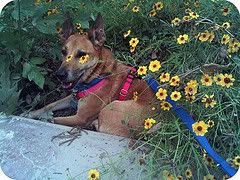Murphy and I were at the dog park a while back. We saw a lady
enter with two dogs. Before letting them off the leash, the lady told
her dogs to sit. The dogs just stood there waiting patiently to be let
off leash. She asked them again in a harsher tone. The dogs just stood
there. She started yelling at the dogs and the dogs just stood there.
Then she started yanking the dogs and they continued to just stand
there. Then she kicked the dogs several times. They still stood there.
Then she yanked, yelled, and kicked at the same time, and the dogs
finally sat. Then she let them off leash to play.
This lady probably thought that the dogs understood “sit” and were
being defiant. She probably also thought that getting tough with them
made them compliant.
A more likely scenario: the dogs had not been “proofed.” They didn’t
know what she was talking about, and they finally sat down either
because they were tired of standing there and/or they started offering
behaviors to try to get their mom to stop yanking and kicking them.
Dogs are very literal. If you teach your dog to sit while she is
standing 2 feet in front of the fridge, then your dog thinks that sit
means “plop my butt down two feet in front of the fridge”. Taking your
dog to a dog park and requesting a sit is like asking a 5 year old to do
algebra one day after showing him how to add 2+2.
In order for your dog to understand that sit means sit anywhere, anytime, you have to “proof” the behavior.
Teach your dog to sit in the kitchen. When the behavior is rock solid,
then teach sit in the living room, then the bedroom, then the back yard,
then the front yard, etc..
Another issue of proofing is distractions. Your dog might understand
sit but might have a hard time doing it while a squirrel is running by.
So start with low distractions - like inside the residence, then mild
distractions like the back yard. Keep slowly adding in distractions.
In order to make sure your dog will sit around other dogs, first
teach the behavior while you are alone. When the behavior is proofed
while alone, then add in fur siblings one at a time then two at a time
etc.. (depending on the size of your family), then add in known dogs
(like dogs who belong to friends and/or family), then friendly calm
unknown dogs (get a trainer to help you with this), then more outgoing
dogs, etc..
You also need to teach the behavior from a variety of positions
(human positions). Ask your dog to sit while you are standing, ask your
dog to sit while you are sitting, ask you dog to sit while you are
laying down. Then start adding in distance. Ask your dog to sit when you
are 6 inches away, then one foot, and so on.
The more variety, the better the proofing and the greater the likelihood that your dog will perform in any situation.
Whenever you change environments, back up in your training and ask
for a little bit less. Your dog might plop down while 2 feet away from
you in the house, but when you move training to the back yard, stand
closer to your dog while requesting a sit. Once the behavior is solid
in the back yard, you can start back asking for the hard stuff.
Pet parents should also be aware that their dogs might have trouble
performing if they are stressed or frightened. My Puddin has a hard
time paying attention when she gets too hot.
From “The Other End of the Leash”
by Patricia McConnell: “This natural tendency to react differently at
different times and in different places explains a tremendous amount of
what looks like ‘disobedience.’ Just as actors tend to forget lines
when they first put on their costumes, our dogs forget their lessons
when we ask them to do things in new contexts…Every dog is indeed
special, and he deserves a human who gives him permission to be who he
is…It’s not fair to expect him to be perfect, although like us, some may
be a little closer than others.
For more info on training and proofing, see Family Friendly Dog Training by Patricia McConnell.
Remember to teach sit or other behaviors using positive reinforcement
only. You don’t need to push on the hind quarters, nor tug up on the
leash. See how to teach sit here:
Sit was just one example. You will need to proof all new behaviors that you ask of your dog.
Tell us about your training experiences in the comments section below

No comments:
Post a Comment